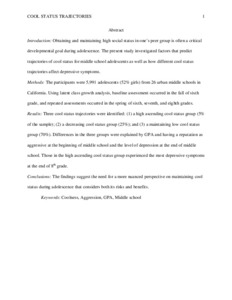Too tough at the top: using latent class growth analysis to assess cool status during middle school.
Graham Sandra; Yun Hye-Young
https://urn.fi/URN:NBN:fi-fe2021042827008
Tiivistelmä
Introduction: Obtaining and maintaining high social status in one’s peer group is often a critical developmental goal during adolescence. The present study investigated factors that predict trajectories of cool status for middle school adolescents as well as how different cool status trajectories affect depressive symptoms.
Methods: The participants were 5,991 adolescents (52% girls) from 26 urban middle schools in California. Using latent class growth analysis, baseline assessment occurred in the fall of sixth grade, and repeated assessments occurred in the spring of sixth, seventh, and eighth grades.
Results: Three cool status trajectories were identified: (1) a high ascending cool status group (5% of the sample); (2) a decreasing cool status group (25%); and (3) a maintaining low cool status group (70%). Differences in the three groups were explained by GPA and having a reputation as aggressive at the beginning of middle school and the level of depression at the end of middle school. Those in the high ascending cool status group experienced the most depressive symptoms at the end of 8th grade.
Conclusions: The findings suggest the need for a more nuanced perspective on maintaining cool status during adolescence that considers both its risks and benefits.
Kokoelmat
- Rinnakkaistallenteet [19207]
